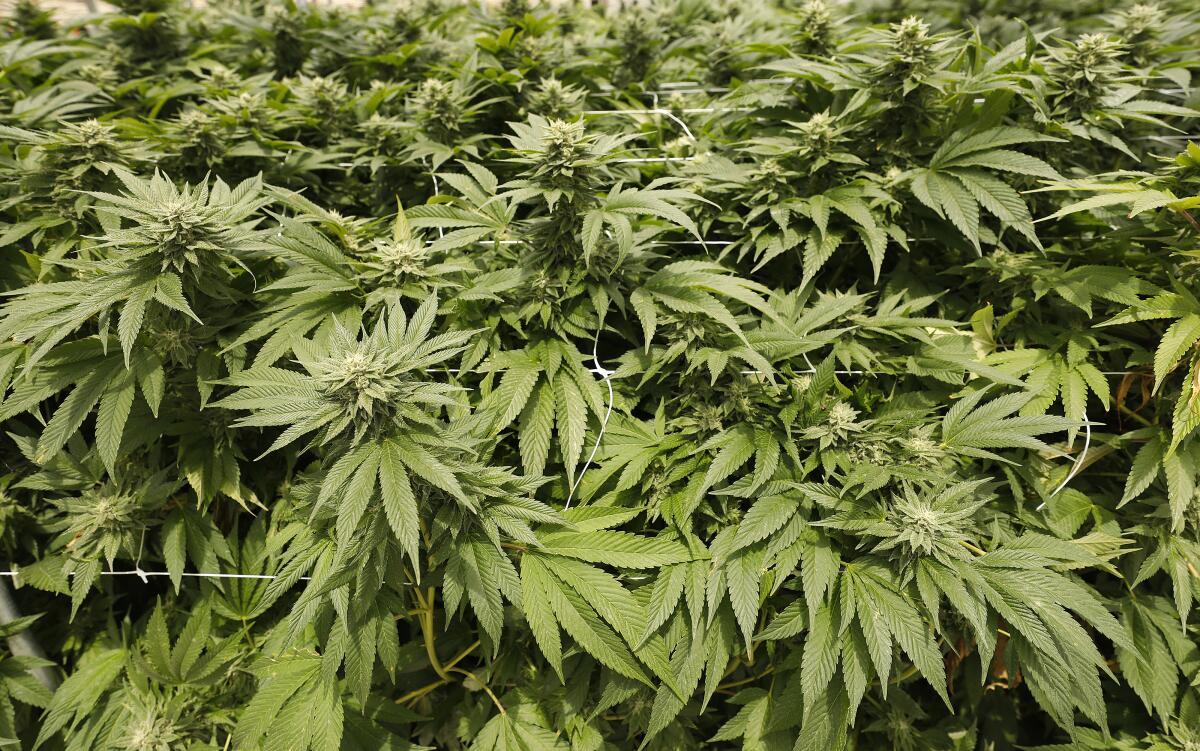Sure, reduce pot taxes. But California needs bigger fixes to its broken marijuana market

- Share via
More than five years after Californians voted to legalize marijuana, the vast majority of pot sold in the state still comes from illegal sellers. To help the floundering legal market, Gov. Gavin Newsom has proposed tax relief in his May budget revision designed to reduce pot prices for three years and help struggling farmers and dispensary owners.
Newsom wants to eliminate the cultivation tax, a flat per-pound fee paid by cannabis farmers, that has gone up each year even as wholesale prices of marijuana have gone down, squeezing profits. That’s a good move, though there’s no guarantee it will result in significant price cuts for consumers. Still, the cultivation tax is poorly designed and ends up hurting small farmers who try to play by the rules.
It’s also a smart, small step toward fixing the state’s marijuana mess that was created, in part, by Proposition 64 — the 2016 ballot measure that legalized the adult use and sale of marijuana. Legalization came with political compromise on taxes and rules that have stymied efforts to move illegal pot operators into the legal marketplace.
Editorial: Californians overwhelmingly supported legalizing marijuana. Why is it still a mess?
The promise of Proposition 64 remains largely unfulfilled five years after passage. California is an example of how not to legalize marijuana.
Newsom’s proposal would raise the 15% excise tax on marijuana sales to 19% in 2025, which officials estimate will bring in enough revenue to make up for the loss of the cultivation tax. During those three years, the state would spend up to $150 million annually to support programs that rely on marijuana tax revenue, including youth education and substance abuse prevention, environmental cleanup of illegal cannabis farms and law enforcement. It’s important to not starve those programs while the state tries to stabilize the legal market.
Newsom’s proposal is not a done deal. Proposition 64 required a two-thirds vote by the Legislature to make significant changes to marijuana laws. Industry groups argue Newsom’s proposal won’t reduce taxes enough to help legal operators compete with the tax-free illicit market, and they’re lobbying to cut the excise tax from 15% to 5%. That would be one of the lowest excise tax rates among states that have legalized recreational use. (California, like many other states, also charges sales tax on purchases. Local jurisdictions can levy their own taxes on cannabis businesses. So, the tax burden would still be significant, even if the excise tax was reduced.)
But tax cuts alone won’t solve the state’s marijuana market mess. There are other major factors that continue to prop up the black market.
Prop. 64 was supposed to shield teenagers from increased exposure to marijuana with major limits on billboard advertising. It hasn’t gone so well.
Two-thirds of jurisdictions still ban marijuana-related businesses, as allowed by Proposition 64’s promise of local control. That doesn’t mean people aren’t selling or buying marijuana in those communities — they’re just doing it illegally, using unlicensed shops or dealers. Newsom wants to create a $20.5-million grant program to help cities develop licensing programs and start to permit pot shops.
Local officials have to acknowledge that refusing to recognize a now-legal industry is only encouraging illicit operators and exposing consumers to untested and unregulated products. In early 2020, authorities seized marijuana vape cartridges from illegal shops in Los Angeles that contained a dangerous additive blamed for an outbreak of deadly lung illnesses.
State and local regulations also make it far too hard to get a license. California’s quasi-legal medical market is decades old, yet the restrictions, costs and hurdles of getting licensed have kept some longtime operators from joining the legal market. In some cases, applicants have to rent space before they can file for a license and have to complete lengthy environmental analysis for a storefront. When businesses do get licensed, they face layers of regulations and restrictions that can be expensive and impractical, such as the state’s 10 p.m. curfew on retail shops and delivery services, particularly when the market is saturated with illegal pot.
To help level the playing field for licensed businesses, the state also needs to ramp up enforcement against illegal operators through strategies such as tax enforcement, administrative penalties and power shutoffs.
High taxes are hurting legitimate pot businesses, and some temporary relief is needed. But the state needs comprehensive reform to save the legal marijuana market.
More to Read
A cure for the common opinion
Get thought-provoking perspectives with our weekly newsletter.
You may occasionally receive promotional content from the Los Angeles Times.











